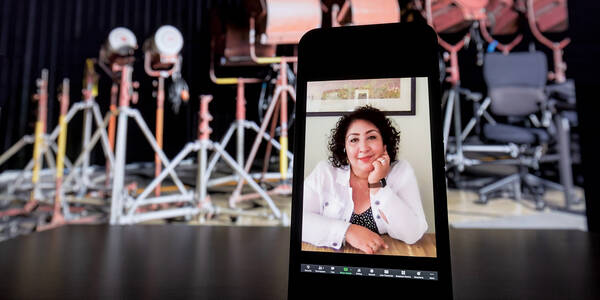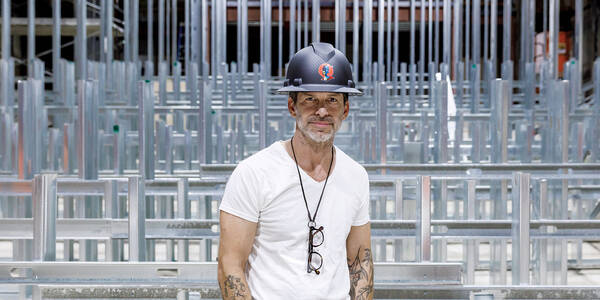
profile / alumni / legacy / product-design / interaction-design / fall-2021
October 25, 2021
Written by Elisabeth Greenbaum Kasson
Alum Sigi Moeslinger Looks Beyond What's Possible Now
“The essence of design is to affect people, and all design is interaction design,” says designer and alumna Sigi Moeslinger (BS 91 Product Design). “Whenever a new artifact is introduced to our life, design has to negotiate between the user, its existing context and the artifact.”
It’s an apt statement coming from Moeslinger, who also received a master’s degree from New York University’s Interactive Telecommunications Program, and whose early research centered around the creation of “hybrid” objects encompassing both the physical and virtual realms.

Moeslinger’s professional design work includes the development of corporate product design languages, user-centered design for consumer products, health care equipment, office furniture, public transportation and future scenarios for new technology products. She is involved in design education as well: She is currently a visiting faculty member and critic at Yale University School of Art and at the School of Visual Arts in New York. But it all began at ArtCenter.
“I knew from the beginning that product design was my major, and it was important to get the knowledge I needed to express my ideas,” Moeslinger recounts, adding that she had been attending ArtCenter Europe and decided to take advantage of the California location. “The plan was for me to stay one term.”
“Coming from the idyllic Swiss campus, Pasadena was a real culture shock,” says Moeslinger with a laugh. “But I stayed.”
She acknowledges that it was her time at ArtCenter that allowed her to see the limitless possibilities of design. She was introduced to the work of the late Syd Mead (BS 59), the visual futurist and “grandfather of concept design” who is best known for many of the iconic visuals seen in the film Blade Runner.
“He really opened my eyes to a type of design I was not familiar with,” she says of Mead. “It wasn’t about product design for use—it was designing, for fiction. That gave me permission to consider potential different futures.”
“A lot of what I studied at ArtCenter prepared me for diverse design,” she continues, adding that what she learned at the College introduced her to unfamiliar methods of thinking and seeing. “I came to understand that things could be quite different from what they are.”
Moeslinger completed her final project, a healthy fast-food restaurant, under the tutelage of the late Gaylord Eckles (BS 70). She immersed herself in its design, trying to learn as much as she could from potential users and other relevant resources.

“I created everything from the logo to the product packaging, to the seating, to the interior,” she says. “It was a big challenge, because it was never an experience with a single object, but the object in context. ArtCenter has equipped me with a strong foundational skillset and a great portfolio.”
As a partner at Antenna Design New York Inc., which she co-founded with Masamichi Udagawa in 1997, she has spearheaded projects that range from public and commercial to experimental and artistic, typically spanning objects, interfaces and environments.
Among Antenna’s best-known projects are the design of New York City subway cars and ticket vending machines; displays and keyboards for accessing Bloomberg Professional Services, the company’s proprietary financial data system; and office furniture collections for Knoll.
Antenna’s work has won many awards, including Moeslinger’s receipt of the United States Artists Target Fellowship in the Architecture and Design Category, and the firm’s receiving the National Design Award in Product Design. Moeslinger’s attention to the context of user experience was critical in working with New York City’s Metropolitan Transportation Authority (MTA). Late in the design process for new ticketing machines, MTA discovered that test users were confounded by the ticket-purchasing experience.
With even longtime riders describing the process as incomprehensible, MTA decided to start over and brought Moeslinger and Udagawa on board to course-correct the project.
The team first considered the incredible diversity of New York subway riders, knowing this would greatly influence the type of experience they would build. They learned they could not assume any familiarity with automated vending machines or touch-screens (this was, after all, the late ’90s).

For the interaction, the Antenna team tested different conceptual models, with the favored “store model” becoming the foundation of the design. They broke content up into multiple, easily comprehensible screens, with the interaction simulating a dialogue between the users and the technology. Subway riders could zip through screens with ease.
Despite her successes on large projects, Moeslinger prefers a broad mix. “Exposure to different people and subjects is most interesting,” she says. “Design is about guiding people’s behavior toward what the ‘program’ or purpose calls for. I don’t want to be locked into one industry or topic, I prefer to shift between scales and industries. I enjoy everything from hand-held fine textures to subway systems.”
During this pandemic, as many people have worked from home, Moeslinger says she’s been thinking even more about the importance of public space. She’s observed how the character of New York City has changed with the advent of year-round outdoor dining—residents are interacting and connecting with one another in new ways.
Moeslinger and her team are currently considering how they can work with the city and its business improvement districts to design public/social furniture that would bring people together. Going forward, she sees herself more involved in transforming outdoor public spaces, making these places greener and more pleasant. She’s looking forward to working on projects that encourage the gathering and social interaction of people from all walks of life, as well as to developing ways to allow people to comfortably work outside, exposing them to the benefits of sunlight and community.
“ArtCenter opened my mind,” she says. “Things can be quite different than they are. We can expand our thinking. We don’t need to be restricted to what’s possible now. We need environments that stimulate our imaginations. We can cross the threshold between product and environment, public and private, physical and digital. Design is all-embracing.”





